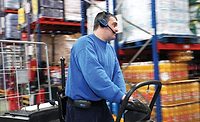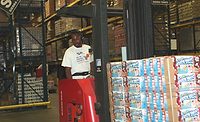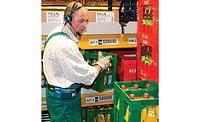Warehouse
Voice-picking technology improving accuracy for distributors
SKU proliferation, safety protocols among key benefits for technology

Voice-guided picking solutions allow for more flexible operations as well as improved accuracy, experts note.
Image courtesy of Honeywell
The letter “S” can be a powerful tool Frog learns in the episode “Robots to the Rescue” of the PBS Kids show “WordWorld.” Finding out that adding “S” at the end of a word can make more than one goes from fun to chaotic for Frog, who turns to his robot inventions to help clean up the mess. Although the creation of new beverages takes more than just adding a “S” to the end of the word, the proliferation of SKUs within warehouses remains a challenge for facility managers as they turn to technology to keep order fulfillment on track.
“SKU proliferation has been one of the largest trends to hit beverage manufacturers and distributors in recent years,” says Paul Hilton, food and beverage lead at Zebra Technologies, Lincolnshire, Ill. “As consumers continue to evolve their tastes, manufacturers and distributors are expected to keep up. Generally, manufacturers can keep up with consumer trends, but the larger challenge of SKU proliferation falls on the distributors and retailers who aren’t able to expand fast enough to keep up with these trends.
“The burden of these changes falls on their shoulders, as they are being asked to carry all of these additional SKUs within the same warehouse footprint using their current processes and existing workforce,” he continues. “One great example of this is National Beer Wholesaler’s membership of distributors, which have seen a 120% increase in SKUs over the last decade. Retailers are in a similar bucket, unable to grow their warehouses and beverage aisles to accommodate all of these new SKUs, leading to some difficult decisions on which items get stocked.”
Kelley Wood, global customer marketing manager of supply chain for Honeywell, Charlotte, N.C., notes that even with the challenges of SKU proliferation, warehouses must be flexible to manage this growth and maintain accuracy.

Image courtesy of Dematic
“For example, increasing inventory of a specific type of product from five SKUs to 20 SKUs naturally can have an impact on how warehouse operations manage this growth,” she explains. “Having a flexible solution like voice-picking technology can help to make the transition to larger SKU volume more manageable. Additionally, SKU proliferation requires that warehouse operations maintain or improve their accuracy.
“Today, the supply chain is expected to deliver a seamless and flawless experience at all points in the value chain,” Wood continues. “Anything less than perfect ― from a poor customer experience to delays in shipping or processing to a cumbersome returns process ― reflects negatively on the business and can prove costly. Adding additional SKUs to a warehouse only compounds this as more and more products become available in one [distribution center] (DC) location.”
Brandon Sechrist, operations solutions director for Encompass Technologies, Fort Collins, Colo., also details the challenges of SKU expansion and how suppliers can reduce stress that can accompany diverse portfolios.
“Warehouse operations are increasingly challenged with having to efficiently and effectively store an ever-growing volume of seasonal and specialty brews in an increasing number of package sizes and configurations,” he explains. “Space management becomes the focus of daily operations: finding the shortage distance to travel to pick the higher volume products while at the same time, being able to locate the slower moving, but critical to the portfolio lower volume products. Picker management tools are imperative for an efficient warehouse operation.”
Although SKU proliferation has impacted warehouse operations, experts also note the growing affect that eCommerce is having on warehouses.
“One cannot talk about trends without mentioning eCommerce,” says Tom Swovick, market development manager of food and beverage for Dematic, Grand Rapids, Mich. “In the first three months of the pandemic, eCommerce experienced the growth that had been projected to be realized in 10 years. We see an ever-increasing growth in subscription-based wine clubs as one instance. Another instance worth noting is PepsiCo’s urban micro-fulfillment pilot selling food and beverage direct-to-consumer.”
Steps toward efficiency
Despite the disruptions the pandemic caused to traditional warehouse operations, suppliers recognize the growing need for technology solutions to support this return.
“Beverage manufacturers and distributors are slowly emerging from the pandemic as consumers do the same,” Zebra Technologies’s Hilton says. “This means that we’re starting to get back to more normal operational routines and a mixed path to markets of points of sale and points of consumption. Restaurants and bars are seeing increased business, meaning more business for beverage operations.
“The industry is also facing a labor shortage, making it difficult for restaurants to both find and retain good talent,” he continues. “Adding technology to warehouse operations will be important to simplify workflows, support associates, and enhance the way they complete work. Voice-picking will be a first step in these efforts, but augmented reality and automation will lead to even greater productivity improvements.”
Honeywell’s Wood notes that voice-guided workflows have enabled safer, more efficient work environments for decades, but with the “new normal” of COVID-19 protocols, this platform can aid four major areas: standardizing processes, executing tasks, optimizing operations and enhancing safety.
“Associates receive clear, verbal instructions that direct them to perform a task — such as where to find a pick location and how many items to select from that position to fill a specific order — with no deviation,” she explains. “This increases accuracy up to 99.9%, minimizing returns. It also boosts productivity by as much as 35%, helping operations meet the challenges of increased customer demand.”
For execution, Wood notes that directives are given in real time and voice allows multiple orders to be handled concurrently to boost efficiency. Additionally, the wireless, mobile devices offered from the company are integrated with the software Honeywell Voice, which collects data and can provide “options for reporting, predictive analytics, and the determination of bottlenecks and other performance inhibitors, contributing to continuous improvement,” she says.
Honeywell Voice also features TouchConnect software, which pairs headsets and terminals to minimize handling. “To further reduce the risks of cross-contamination, workers can be assigned individual devices (headsets and body-worn terminals) or replaceable consumables (headbands and protective windscreens to shield the headset microphone),” Wood says. “Shared components can be easily cleaned and sanitized before and after use to further safeguard employee health.”
Encompass Technologies’ Sechrist adds that voice technology is adaptive for onboarding new employees thanks to various capabilities including language fluency.
“Voice-pick enables rapid employee onboarding, while also making the job experience a successful one for the employee and the warehouse team,” he explains. “Warehouse managers are not dependent on learning a product's location and instead use the space to match product sales velocity and minimize travel time. Voice-pick provides multi-language support, so whether your employees are native English speakers or fluent in Spanish, Korean or another language, they can be productive and increase their cases per hour pick rate.”
Kyle Nevenhoven, principal consultant of food and beverage for Dematic, highlights that the platform has seen significant changes the past few years, enhancing its reach within the warehouse.
“One major change is the ability to run voice-picking applications on consumer grade/less expensive devices such as those running Android OS versus industrial grade, purpose built mobile computing technology,” he explains. “Voice has also been introduced to functions beyond just picking, taking up replenishment, quality control, staging and trailer loading functionality tasks to support the picking process.
“Another trend being seen in voice-picking is the inclusion of a visual component, often seen in use with wearable technologies where an operator can interact by way of both voice and touch,” Nevenhoven continues. “The advantages and disadvantages of this trend can be debated, as although a touch can be quicker than a string of voice commands, looking at and interacting with the screen reduces some of the hands-free advantages of voice technology. Lastly, voice is now being integrated with automation technologies that are made to enhance the productivity of traditional pick-to-voice operations.”
Noting that voice-pick solutions have become an integral part of today’s warehouses, Encompass Technologies’ Sechrist anticipates the technology will remain a go-to source for beverage operations.
“As mobile devices and headsets improve in quality, battery life, and ease of use, voice-pick becomes the gold standard,” he says. “Voice-pick software continues to evolve, routing pick tasks based on team, warehouse location, package/pallet size, and product type to keep the workforce moving.”
Looking for a reprint of this article?
From high-res PDFs to custom plaques, order your copy today!







